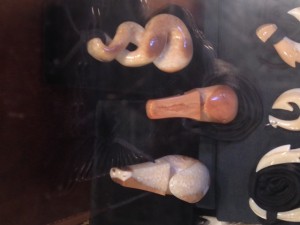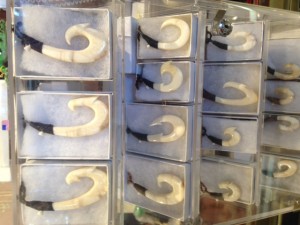Context:
I was wandering through some of the shops in Lahaina, wondering about the abundance of fishhooks that could be worn as necklaces. So I asked one of the shopkeepers about them.
Interview:
Me: So I was curious as to where the practice of wearing fishhooks originated. Do you know?
Informant: There are many wild tales as to how the practice started. I had a customer about ten years ago who was very concerned about because of his religious beliefs. He wanted to buy a fishhook but was worried about its pagan connotations.
Me: Okay. Makes some sense I suppose.
Informant: Yes. So I contacted a friend who lives on another island about this. And his response was that the Hawaiians never wore their fishhooks.
Me: Okay.
Informant: The Hawaiians were a purely practical culture. And for them, they would not have worn their fishhooks as ornamentation. They would only carve them to use. So when you hear these legends of safe voyage and this and that – that is not true. However, I do have some examples of one of the few things that the Hawaiians did wear. You see these things here that look like hooks? [Pictured above]
Me: Yeah.
Informant: They look like hooks, but they’re not. They are something that was only worn by the royalty, the ali’i, or the representative of a royal. They are called paloas, which roughly translates as “whale’s tooth” or “tongue of the chief,” and they would wear massive ones on dozens of strands of braids. And that was one of the few things that the Hawaiians wore as a culture. This then translated, over time, along with the importance of the fishhook to the Hawaiian peoples, into the practice of wearing fishhooks as ornamentation. Also, these are mostly Maori designs that we have, not Polynesian. So this is one possible origin of the fishhook as ornamentation. I hope that answers you questions.
Me: Yes. It does. Thank you very much.
Informant: You’re welcome
Analysis:
To me, it is odd that something that has become such a major part of the consumer culture of Hawaii, something that is often seen as being traditional Hawaiian ornamentation, actually was not used for ornamentation at all. Yes, the fishhook is an incredibly important aspect of the Hawaiian culture, as the Hawaiian’s main source of protein came from the sea. There were no large land animals, no large game birds. Pigs, cattle, cats, dogs, and chickens only came to the Hawaiian Islands when the Europeans brought them. Thus, the fishhook would have been extremely important to the Hawaiians, an idea that was then taken by the tourist industry and turned into a decorative consumer item. I personally even have a fishhook on a length of cord that I got in Hawaii (the Big Island) years ago. Yet, the fishhook as decorative ornamentation has become so ingrained in Hawaiian culture that it might as well have become a folk tradition. It has become part of the traditional Hawaiian culture.


